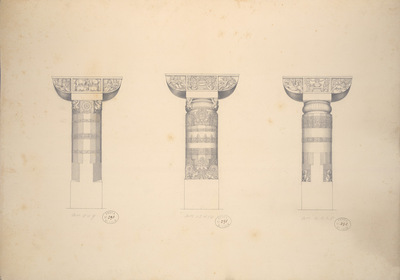Javascript must be enabled to continue!
Cave 1, Details of Pillars f.34
View through Europeana Collections
Pencil drawing of pillars from Cave 1 at Ajanta,
from an Album of 26 ground plans of the Ajanta caves and 16 folios
of drawings of sculpture and architectural details in the Ajanta
caves, by Capt. R. Gill, dated c.1850.The magnificent cave temples
of Ajanta are situated in a horse-shoe valley of the Waghora river
in West India and consist of prayer halls (chaityas) and
monasteries (viharas), built for the Buddhist community who lived
there. The first group was excavated between the second - first
centuries BC; then, after a period of more than six centuries, the
excavations restarted around the fifth century AD, in the Vakataka
period. Cave 1, excavated in the late fifth century, is one of the
finest monastery of Ajanta. One of the most striking element of
this, and most of the other caves, are the imposing pillars that
support the wide ceilings. This drawing depicts three types of
pillars found in the cave. They have a square base; the shafts are
octagonal at the beginning and then become fluted and are richly
carved with floral bands, monsters' faces with jewelled motifs. The
capitals consist of compressed amalaka fruits, two of them with
figures of dwarfs or ghanas that support a square abacus. The
brackets are carved with flying couples and figures riding lions,
flanking a compartment with figures adorating a stupa and deers.
The cave is renowned for the magnificent painting it has preserved
on its walls depicting scenes from the previous lives of Buddha as
narrated in the Jatakas.
The British Library
Title: Cave 1, Details of Pillars f.34
Description:
Pencil drawing of pillars from Cave 1 at Ajanta,
from an Album of 26 ground plans of the Ajanta caves and 16 folios
of drawings of sculpture and architectural details in the Ajanta
caves, by Capt.
R.
Gill, dated c.
1850.
The magnificent cave temples
of Ajanta are situated in a horse-shoe valley of the Waghora river
in West India and consist of prayer halls (chaityas) and
monasteries (viharas), built for the Buddhist community who lived
there.
The first group was excavated between the second - first
centuries BC; then, after a period of more than six centuries, the
excavations restarted around the fifth century AD, in the Vakataka
period.
Cave 1, excavated in the late fifth century, is one of the
finest monastery of Ajanta.
One of the most striking element of
this, and most of the other caves, are the imposing pillars that
support the wide ceilings.
This drawing depicts three types of
pillars found in the cave.
They have a square base; the shafts are
octagonal at the beginning and then become fluted and are richly
carved with floral bands, monsters' faces with jewelled motifs.
The
capitals consist of compressed amalaka fruits, two of them with
figures of dwarfs or ghanas that support a square abacus.
The
brackets are carved with flying couples and figures riding lions,
flanking a compartment with figures adorating a stupa and deers.
The cave is renowned for the magnificent painting it has preserved
on its walls depicting scenes from the previous lives of Buddha as
narrated in the Jatakas.
Related Results
Cave 1, Details of Pillars f.33
Cave 1, Details of Pillars f.33
Pencil drawing of pillars and pilasters from Cave
1 at Ajanta, from an Album of 26 ground plans of the Ajanta caves
and 16 folios of drawings of sculpture and architectural details...
Cave 1, Details of Pillars f.30
Cave 1, Details of Pillars f.30
Pencil drawing of pillars from Cave 1 at Ajanta,
from an Album of 26 ground plans of the Ajanta caves and 16 folios
of drawings of sculpture and architectural details in the Ajanta...
Cave 2, Entrance to Cell at Right Hand End of Porch
Cave 2, Entrance to Cell at Right Hand End of Porch
Pencil drawing of the entrance to the cell at the
right hand end of the porch of Cave 2 at Ajanta, from an Album of
26 ground plans of the Ajanta caves and 16 folios of drawings of...
General view of cave temples in the Barabar Hills, Gaya
(Bihar). January 1814
General view of cave temples in the Barabar Hills, Gaya
(Bihar). January 1814
Water-colour of the cave temples in the Barabar
Hills, at Gaya in Bihar, dated January 1814. Inscribed on front in
ink: 'View of the Rock of the Caverns at - mile from Ghya.' '
Jan...
Entrance to the cave temple of Karle. Copy of an original
sketch of 1805
Entrance to the cave temple of Karle. Copy of an original
sketch of 1805
Water-colour by James Broff Byers of the entrance
to the cave temple of Karle, dated 1815. Inscribed on reverse:
'View of the Entrance, or External Appearance of the magnificent
Ca...
Cave 2, Sculptures in Subsidiary Shrines
Cave 2, Sculptures in Subsidiary Shrines
Pencil drawing of the sculptures in one of the
subsidiary shrine of Cave 2 at Ajanta, from an Album of 26 ground
plans of the Ajanta caves and 16 folios of drawings of sculpture
an...
illustration; print (art)
illustration; print (art)
Two illustrations of Landscape Scene. The painting at the bottom illustrates part of the Lotus Sutra (Fahuajing) in Cave 112. Copied from mural paintings in Cave 172 (top) and Cave...
Ajanta: Cave XVII. Painting in the verandah
Ajanta: Cave XVII. Painting in the verandah
Illustration of the painting in the verandah from
the Buddhist vihara, Cave XVII at Ajanta, from James Burgess'
'Original Drawings from the Buddhist Rock Temples at
Ajanta.'Â The B...




